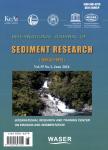Bioremediation perspective of historically contaminated sediment with polycyclic aromatic hydrocarbons
Bioremediation perspective of historically contaminated sediment with polycyclic aromatic hydrocarbons作者机构:Department of Chemistry Biochemistry and Environmental Protection Faculty of Sciences University of Novi Sad
出 版 物:《International Journal of Sediment Research》 (国际泥沙研究(英文版))
年 卷 期:2021年第36卷第4期
页 面:479-488页
核心收录:
基 金:support of the Ministry of Education Science and Technological Development of the Republic of Serbia (Grant No. x451-03-68/2020-14/200125)
主 题:Contaminated sediment Bioavailability PAH Biodegradation
摘 要:The purpose of the current study is to compare the influence of different aerobic conditions(biostimulation(BS), bioaugmentation(BA), and a combination of biostimulation and bioaugmentation(BB))on polycyclic aromatic hydrocarbons(PAH) degradation and compare the degraded amount with single step XAD-4 extraction as a new tool for bioavailability assessment for chronically contaminated sediment samples obtained from territory of Autonomous Province Vojvodina of Serbia(S1, S2, and S3). A great number of papers dealing with biodegradation of PAHs in spiked sediment or soil have been published,but to the authors knowledge, a limited number of papers studied aged, historically polluted sediment and a sum of chosen U.S. Environmental Protection Agency(USEPA) PAHs. A significant reduction(up to67%) in PAH concentration was observed, while the percentage of reduction varied depending on the sediment sample and treatment used. BS treatment successfully stimulated growth of indigenous bacteria. Further, PAH-degrading strain Sphingomonas paucimobilis F8 inoculated in BA and BB treatment survived for up to 7 weeks after it was suppressed by unfavorable conditions or native *** amounts generally showed good correlation with results obtained from XAD-4 *** obtained in the current study represent a good start for standardizing a XAD-4 extraction technique as a simplified, easier, and lower cost method for bioavailability assessment.



